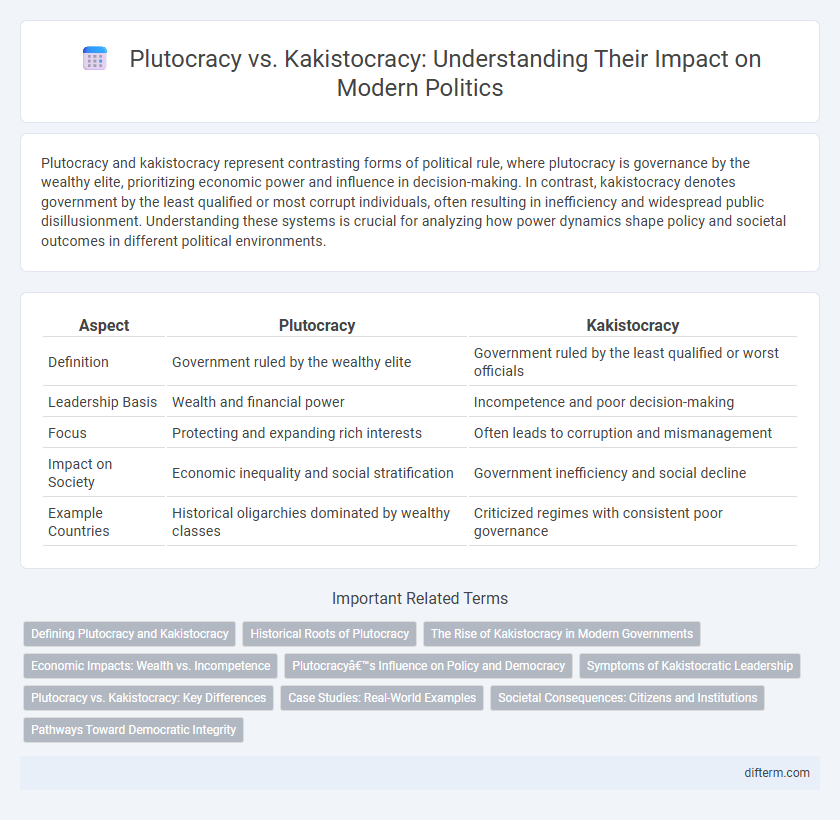Plutocracy and kakistocracy represent contrasting forms of political rule, where plutocracy is governance by the wealthy elite, prioritizing economic power and influence in decision-making. In contrast, kakistocracy denotes government by the least qualified or most corrupt individuals, often resulting in inefficiency and widespread public disillusionment. Understanding these systems is crucial for analyzing how power dynamics shape policy and societal outcomes in different political environments.
Table of Comparison
| Aspect | Plutocracy | Kakistocracy |
|---|---|---|
| Definition | Government ruled by the wealthy elite | Government ruled by the least qualified or worst officials |
| Leadership Basis | Wealth and financial power | Incompetence and poor decision-making |
| Focus | Protecting and expanding rich interests | Often leads to corruption and mismanagement |
| Impact on Society | Economic inequality and social stratification | Government inefficiency and social decline |
| Example Countries | Historical oligarchies dominated by wealthy classes | Criticized regimes with consistent poor governance |
Defining Plutocracy and Kakistocracy
Plutocracy is a political system where power is primarily held by the wealthy elite, influencing government decisions through financial means and economic dominance. Kakistocracy, on the other hand, describes a government run by the least qualified or most unscrupulous individuals, often resulting in corruption and inefficiency. These contrasting systems highlight the impact of wealth concentration versus governance competence on political stability and public policy outcomes.
Historical Roots of Plutocracy
Plutocracy, a system where wealth dictates political power, traces its historical roots to ancient city-states like Athens and Rome, where affluent elites controlled governance and policy decisions. Throughout history, emerging capitalist societies in Europe further entrenched plutocratic rule by linking property ownership and political influence, notably during the Renaissance and the Industrial Revolution. This concentration of wealth and power contrasts with kakistocracy, where governance is marked by rule of the least qualified or most corrupt, highlighting different dynamics in the struggle for political control.
The Rise of Kakistocracy in Modern Governments
The rise of kakistocracy in modern governments manifests through the increasing presence of least qualified or most corrupt individuals in positions of political power, undermining democratic institutions and public trust. Unlike plutocracy, which centers power in the hands of the wealthy elite, kakistocracy destabilizes governance by prioritizing personal gain and incompetence over effective policy-making. This trend contributes to systemic inefficiencies, widespread corruption, and weakened accountability mechanisms across various countries worldwide.
Economic Impacts: Wealth vs. Incompetence
Plutocracy concentrates economic power in the hands of the wealthy elite, often leading to policies that favor capital accumulation and market monopolies, which can exacerbate income inequality and limit social mobility. In contrast, kakistocracy--government by the least qualified--frequently results in inefficient resource allocation, corruption, and weakened economic institutions, undermining fiscal stability and growth prospects. The economic impact of plutocracy centers on wealth concentration, while kakistocracy risks systemic incompetence that destabilizes economies and erodes public trust.
Plutocracy’s Influence on Policy and Democracy
Plutocracy, characterized by the dominance of wealthy elites in political decision-making, significantly shapes policy outcomes by prioritizing the interests of the affluent over the broader population. This concentration of economic power often undermines democratic principles by limiting political equality and skewing representation toward the wealthy class. As a result, policies may reinforce economic disparities and erode public trust in democratic institutions.
Symptoms of Kakistocratic Leadership
Kakistocratic leadership is characterized by rampant corruption, incompetence, and the prioritization of personal gain over public welfare, leading to ineffective governance and social unrest. Such regimes often exhibit nepotism, cronyism, and a blatant disregard for democratic institutions, eroding public trust and institutional integrity. The resulting policy failures and economic mismanagement contribute to widening inequality and the breakdown of legal frameworks essential for stable governance.
Plutocracy vs. Kakistocracy: Key Differences
Plutocracy is a political system where power is concentrated in the hands of the wealthy elite, often leading to policies that favor economic interests and wealth accumulation. Kakistocracy, by contrast, describes governance by the least qualified or most unscrupulous individuals, resulting in widespread corruption and mismanagement. The fundamental difference lies in plutocracy's wealth-based rule versus kakistocracy's incompetent and unethical leadership, both undermining democratic principles but through distinct mechanisms.
Case Studies: Real-World Examples
Plutocracy is exemplified by nations like Russia, where wealthy oligarchs wield significant influence over political decisions and maintain control over key industries. Kakistocracy is evident in countries such as Venezuela under Nicolas Maduro, where corrupt and incompetent leadership has led to economic collapse and social unrest. These case studies illustrate how concentrated wealth drives policy in plutocracies, while kakistocracies suffer from governance by the least qualified individuals, causing widespread dysfunction.
Societal Consequences: Citizens and Institutions
Plutocracy concentrates power in the hands of the wealthy elite, leading to policies favoring economic inequality and weakened social mobility, which often erodes public trust in democratic institutions. Kakistocracy, rule by the least qualified or most unscrupulous leaders, results in inefficiency, corruption, and weakened governance structures that destabilize societal norms and diminish institutional accountability. Both systems compromise citizens' rights and institutional integrity, fostering social unrest and diminishing the overall quality of democracy.
Pathways Toward Democratic Integrity
Plutocracy consolidates power among the wealthiest elite, undermining democratic integrity by prioritizing financial influence over equitable representation. Kakistocracy, a government led by the least qualified or most corrupt, erodes public trust and hampers effective policy-making critical for democratic stability. Pathways toward democratic integrity involve implementing transparency measures, enhancing civic engagement, and enforcing accountability to counteract the distortions caused by both plutocratic and kakistocratic systems.
Plutocracy vs Kakistocracy Infographic

 difterm.com
difterm.com